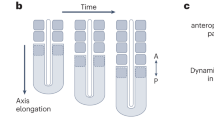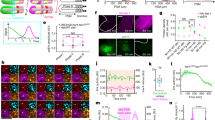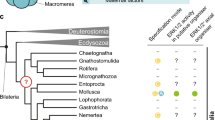Abstract
A striking feature of the body plan of a majority of animals is bilateral symmetry. Almost nothing is known about the mechanisms controlling the symmetrical arrangement of the left and right body sides during development. Here we report that blocking the production of retinoic acid (RA) in chicken embryos leads to a desynchronization of somite formation between the two embryonic sides, demonstrated by a shortened left segmented region. This defect is linked to a loss of coordination of the segmentation clock oscillations1. The lateralization of this defect led us to investigate the relation between somitogenesis and the left–right asymmetry machinery2,3 in RA-deficient embryos. Reversal of the situs in chick4,5 or mouse6 embryos lacking RA results in a reversal of the somitogenesis laterality defect. Our data indicate that RA is important in buffering the lateralizing influence of the left–right machinery, thus permitting synchronization of the development of the two embryonic sides.
This is a preview of subscription content, access via your institution
Access options
Subscribe to this journal
Receive 51 print issues and online access
$199.00 per year
only $3.90 per issue
Buy this article
- Purchase on Springer Link
- Instant access to full article PDF
Prices may be subject to local taxes which are calculated during checkout




Similar content being viewed by others
References
Pourquie, O. The segmentation clock: converting embryonic time into spatial pattern. Science 301, 328–330 (2003)
Raya, A. & Belmonte, J. C. Sequential transfer of left-right information during vertebrate embryo development. Curr. Opin. Genet. Dev. 14, 575–581 (2004)
Levin, M. Left-right asymmetry in embryonic development: a comprehensive review. Mech. Dev. 122, 3–25 (2005)
Levin, M. et al. Left/right patterning signals and the independent regulation of different aspects of situs in the chick embryo. Dev. Biol. 189, 57–67 (1997)
Pagan-Westphal, S. M. & Tabin, C. J. The transfer of left-right positional information during chick embryogenesis. Cell 93, 25–35 (1998)
Brueckner, M., D'Eustachio, P. & Horwich, A. L. Linkage mapping of a mouse gene, iv, that controls left-right asymmetry of the heart and viscera. Proc. Natl Acad. Sci. USA 86, 5035–5038 (1989)
Dubrulle, J. & Pourquie, O. Coupling segmentation to axis formation. Development 131, 5783–5793 (2004)
Diez del Corral, R. et al. Opposing FGF and retinoid pathways control ventral neural pattern, neuronal differentiation, and segmentation during body axis extension. Neuron 40, 65–79 (2003)
Moreno, T. A. & Kintner, C. Regulation of segmental patterning by retinoic acid signaling during Xenopus somitogenesis. Dev. Cell 6, 205–218 (2004)
Stratford, T., Horton, C. & Maden, M. Retinoic acid is required for the initiation of outgrowth in the chick limb bud. Curr. Biol. 6, 1124–1133 (1996)
Maden, M., Sonneveld, E., van der Saag, P. T. & Gale, E. The distribution of endogenous retinoic acid in the chick embryo: implications for developmental mechanisms. Development 125, 4133–4144 (1998)
Vermot, J. et al. Retinoic acid controls the bilateral symmetry of somite formation in the mouse embryo. Science 308, 563–566 (2005)
Pourquie, O. & Tam, P. P. A nomenclature for prospective somites and phases of cyclic gene expression in the presomitic mesoderm. Dev. Cell 1, 619–620 (2001)
Maden, M., Graham, A., Zile, M. & Gale, E. Abnormalities of somite development in the absence of retinoic acid. Int. J. Dev. Biol. 44, 151–159 (2000)
Niederreither, K., Subbarayan, V., Dolle, P. & Chambon, P. Embryonic retinoic acid synthesis is essential for early mouse post-implantation development. Nature Genet. 21, 444–448 (1999)
Dale, J. K. et al. Periodic Notch inhibition by Lunatic Fringe underlies the chick segmentation clock. Nature 421, 275–278 (2003)
Buchberger, A., Seidl, K., Klein, C., Eberhardt, H. & Arnold, H. H. cMeso-1, a novel bHLH transcription factor, is involved in somite formation in chicken embryos. Dev. Biol. 199, 201–215 (1998)
Psychoyos, D. & Stern, C. D. Fates and migratory routes of primitive streak cells in the chick embryo. Development 122, 1523–1534 (1996)
Piedra, M. E., Icardo, J. M., Albajar, M., Rodriguez-Rey, J. C. & Ros, M. A. Pitx2 participates in the late phase of the pathway controlling left-right asymmetry. Cell 94, 319–324 (1998)
Meyers, E. N. & Martin, G. R. Differences in left-right axis pathways in mouse and chick: functions of FGF8 and SHH. Science 285, 403–406 (1999)
Raya, A. et al. Notch activity induces Nodal expression and mediates the establishment of left-right asymmetry in vertebrate embryos. Genes Dev. 17, 1213–1218 (2003)
Krebs, L. T. et al. Notch signaling regulates left-right asymmetry determination by inducing Nodal expression. Genes Dev. 17, 1207–1212 (2003)
Raya, A. et al. Notch activity acts as a sensor for extracellular calcium during vertebrate left-right determination. Nature 427, 121–128 (2004)
Kawakami, Y., Raya, Á., Marina Raya, R., Rodríguez-Esteban, C. & Izpisúa Belmonte, J. C. Retinoic acid signalling links left–right asymmetric patterning and bilaterally symmetric somitogenesis in the zebrafish embryo. Nature doi:10.1038/nature03512 (this issue)
Schubert, M., Holland, L. Z., Stokes, M. D. & Holland, N. D. Three amphioxus Wnt genes (AmphiWnt3, AmphiWnt5, and AmphiWnt6) associated with the tail bud: the evolution of somitogenesis in chordates. Dev. Biol. 240, 262–273 (2001)
Hamburger, V. & Hamilton, H. L. A series of normal stages in the development of the chick embryo. J. Morphol. 88, 49–92 (1951)
Chapman, S. C., Collignon, J., Schoenwolf, G. C. & Lumsden, A. Improved method for chick whole-embryo culture using a filter paper carrier. Dev. Dyn. 220, 284–289 (2001)
Henrique, D. et al. Expression of a Delta homologue in prospective neurons in the chick. Nature 375, 787–790 (1995)
Adachi, H. et al. Determination of left/right asymmetric expression of nodal by a left side-specific enhancer with sequence similarity to a lefty-2 enhancer. Genes Dev. 13, 1589–1600 (1999)
Acknowledgements
We thank P. Chambon for his interest in this work; P. Dollé for discussions and for providing the Raldh2 mice; H. Hamada for providing the iv genotyping protocol; members of the Pourquié laboratory for sharing reagents and helpful discussions, especially T. Iimura for sharing his expertise with chick culture; B. Brede and P. Malapert for help with mouse genotyping; S. Esteban for artwork; and members of the Conaway and Workman laboratories, particularly J. Conaway and A. Paoletti for help with RP-HPLC, and J. Chen (on leave from University of Missouri – Kansas City) for help with the statistics. J.V. was supported by the Fondation pour la Recherche Médicale and by a Travelling Fellowship from the Company of Biologists and is on leave from IGBMC, Institut de Génétique et de Biologie Moléculaire et Cellulaire, Strasbourg, France. Present work is supported by the Stowers Institute for Medical Research and by a grant from the NIH.
Author information
Authors and Affiliations
Corresponding author
Ethics declarations
Competing interests
The authors declare that they have no competing financial interests.
Supplementary information
Supplementary Figure S1
Standard curve obtained by RP-HPLC after injection of different amounts of synthetic RA. Vertical bars represent the standard deviation. (JPG 103 kb)
Supplementary Figure S2
RA treatment rescues the somitogenesis asymmetry of disulphiram-treated embryos. (JPG 349 kb)
Rights and permissions
About this article
Cite this article
Vermot, J., Pourquié, O. Retinoic acid coordinates somitogenesis and left–right patterning in vertebrate embryos. Nature 435, 215–220 (2005). https://doi.org/10.1038/nature03488
Received:
Accepted:
Issue Date:
DOI: https://doi.org/10.1038/nature03488
This article is cited by
-
Reconstituting human somitogenesis in vitro
Nature (2023)
-
Laterality in modern medicine: a historical overview of animal laterality, human laterality, and current influences in clinical practice
European Journal of Plastic Surgery (2022)
-
Pitx controls amphioxus asymmetric morphogenesis by promoting left-side development and repressing right-side formation
BMC Biology (2021)
-
Highlighting the gaps in hazard and risk assessment of unregulated Endocrine Active Substances in surface waters: retinoids as a European case study
Environmental Sciences Europe (2021)
-
Characterising open chromatin in chick embryos identifies cis-regulatory elements important for paraxial mesoderm formation and axis extension
Nature Communications (2021)
Comments
By submitting a comment you agree to abide by our Terms and Community Guidelines. If you find something abusive or that does not comply with our terms or guidelines please flag it as inappropriate.



